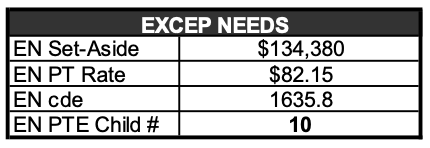Lesson
Dashboard
Lesson 1
Family Selection
Lesson 2
Family Data File
Lesson 3
Attendance
Lesson 4
Parent Involvement & Education
Lesson 5
Health & Social Services
Lesson 6
Site Licensure & License Exempt
Lesson 7
Staff-Child Ratios
Lesson 8
Classroom Assessment System
Lesson 9
Nutritional Needs
Lesson 10
Desired Results Profile & Data
Lesson 11
Qualified Staff & Director
Lesson 12
Staff Development Program
Lesson 13
Refrain from Religious Instruction
Lesson 14
Inventory Records
Lesson 15
Annual Evaluation Plan
Lesson 16
Contract/Fiscal
Introduction to
Projections
A successful organization:
Must have sound fiscal management
Does not spend more than they will earn
Manages enrollment & projections to ensure their contract is fully maximized
Reference
Watch Video Lesson ❯
Sample Forms/Tools ❯
Review Sketch Pad Notes ❯
Gather
When preparing an enrollment & projections plan, you must gather the following information:
Contract
Program Type
Maximum Reimbursable Amount (MRA)
Contract Rate (Per-Child Reimbursement)
Minimum Days of Operation (MDO)
Predict
Interest Revenue
Average Vacancy Rate
Center Capacity
Plan
There are many worksheets out there that programs use to create an enrollment & projections plan.
To show what should be considered when planning enrollment & projections we will be using Monarch Link’s sample Part-Day State Preschool worksheet.
In the event that the contractor serves children in multiple counties AND the different counties have a different Contract Rate, then separate program worksheets will be needed.
For the purpose of planning, within the worksheet the TEAL COLOR CELLS are inputted AND adjusted as changes occur
Program Overview Data
Enter data into Program Overview section for each program type & if applicable each county.
EXAMPLE:
TOTAL FUNDS:
Contract MRA: Contract Maximum Reimbursable Amount (MRA) is $1,119,831
Family Fees: No fees are collected for Part-Day State Preschool programs.
Interest: Predicting to receive $250 of interest (Interest revenue pertains to interest earned on apportionment payments received from the department if apportionments are placed in an interest-bearing account)
VACANCY RATE VALUE:
Vacancy Rate: Based on history of target enrollment compared to actual enrollment numbers.
As we transition out of hold harmless this upcoming fiscal year, service earnings will impact reimbursement; therefore, a vacancy value should be part of enrollment planning.
Vacancy Value: (Total Funds $1,120,081 x Vacancy Rate 3% = $33,602
Vacancy cde Value: (Vacancy Value $33,602/Contract Rate $55.27 = FTE cdes 608
Between now and then, vacancy rate history is being developed that later will be used to determine the vacancy rate.
PTE CHILD COUNT:
Part Day Contract Rate: Based on contract rate x the county part-time adjustment factor, the Part Day Contract Rate is $34.23
Minimum Days of Operation (MDO): MDO of 177 was determined by the annual service calendar & included on contract
Number of child days of enrollment (cde):
(Total Funds $1,119,831 + Vacancy Rate Value $33,602)/Part Day Contract Rate $34.23 = PTE cdes 33,705Estimated number of daily children:
cdes 33,705/ MDO 177 = PTE Child Count 190
(4 years or older)
EXCEPTIONAL NEEDS SET-ASIDE:
To determine how many exceptional needs children at a minimum are needed. The exceptional needs child days of enrollment of 1,635.8 are divided by the minimum days of operation 177, which gives us a total of 9.24 children. Since you cannot serve part of a child, the formula is built to always round up. In this example a minimum of 10 part-time exceptional need children must be enrolled at all times to meet the 5% set-aside.
Composition
Next, determine the composition of where children will be served, adjustment factors, child counts & the days of operation. Let’s walk through this.
EXAMPLE:
SITE INFO:
Look at each available classroom, what the capacity is & what age group you will be putting in each classroom.
Make enrollment targets for each classroom.
If you will be co-mingling any of the classrooms with Head Start only children or private pay children, be sure to take into consideration too
ADJUSTMENT FACTORS & CHILD COUNT:
Analyze the certified schedule of enrollment for each child according to the Application for Services.
Based on the analysis record the Child Count AND Adjustment Factor based on:
Age
Time-base category
Special Circumstance
DAYS OF OPERATION:
For each row input the total days of operation per month children plan to be served within the applicable category
NOTE: The total cde for each row/category is automatically calculated as follows:
(Total Days of Operation x Adjustment Factor) x Child Count = cde Total
Manage
In a typical year, it is important to complete monthly projections. It is not a good idea to wait until you receive the quarterly Earnings Projection Worksheet from the Department to see their projections.
When you are over- or under-earning, you must respond quickly. By the time you can enroll 1 family up to 4 months may have gone by.
Input "Actuals"
To manage projections, each month you will need to input the Actuals
For the purpose of managing projections, within the worksheet the PEACH COLOR CELLS must be updated monthly to determine if child enrollment needs adjusted
Actual cde: Input actual cde based on attendance reports
Actual Remaining Days: Input the days of operation remaining
Analyze & Adjust (if needed)
Closely monitor actual earnings (cde) & vacancy rate. When analyzing the projection worksheet, ask yourself?
Compare the percent of projected vs actual cde earned. Is the vacancy rate on track?
Is the program short (under-earning/enrolled) or over (over-earning/enrolled) the contract based on cde?
If under-earning/enrolled, how many more children do we need to enroll?
If over-earning/enrolled, can we afford to keep the current amount of children enrolled? Do we have a nice “cushion” to support any potential future under-earning/enrollment?
Complete Knowledge Check ❯
After reviewing the video lesson & sketch pad notes, it’s time to check for understanding by completing a Knowledge Check. Note that Individual Knowledge Checks will conclude with a Certificate.











